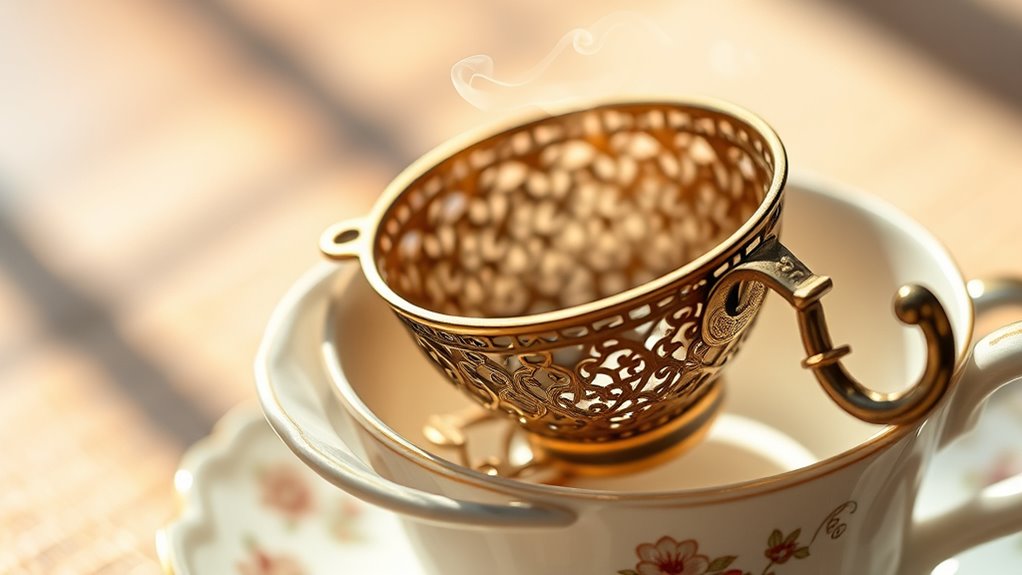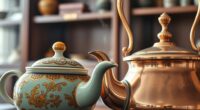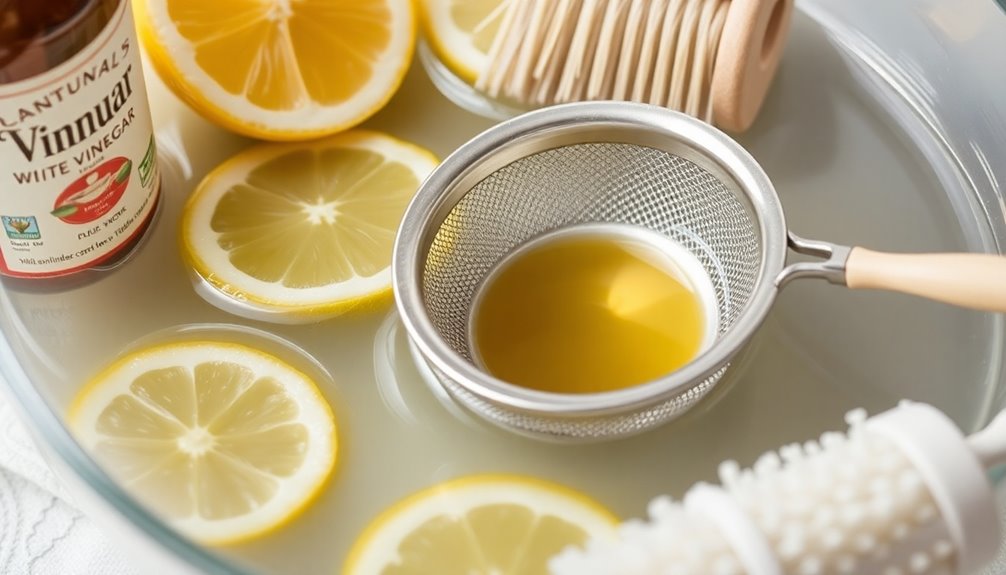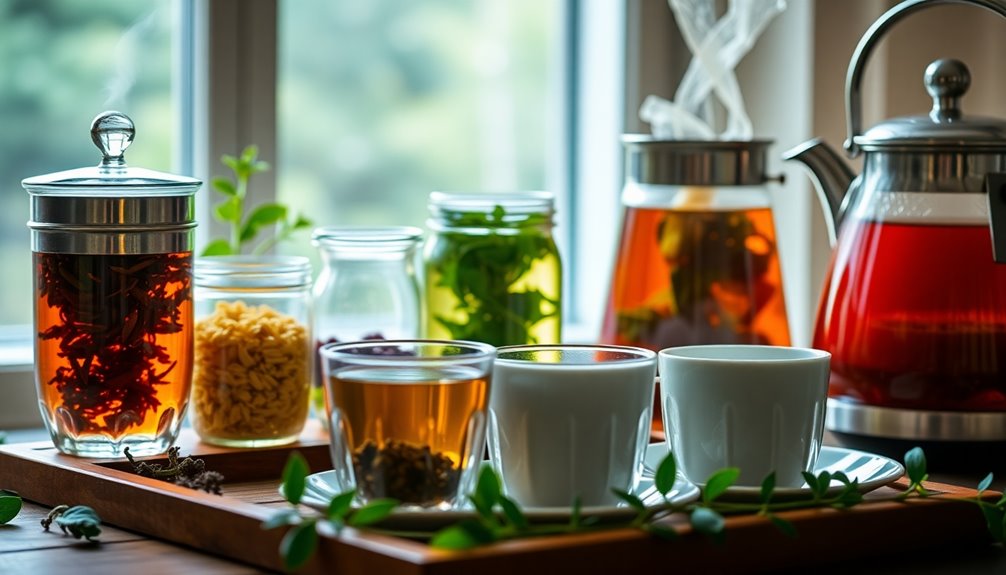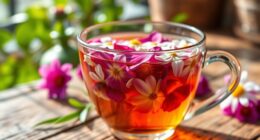Tea infusers and strainers hold deep cultural significance, reflecting centuries of tradition and craftsmanship. Different materials, like ceramic, bamboo, or metal, connect to specific tea customs around the world. They symbolize both age-old rituals and modern innovation, blending history with contemporary taste. By exploring their designs and materials, you’ll gain a richer understanding of the cultural stories behind tea. Keep exploring to uncover how these simple tools can carry centuries of meaning.
Key Takeaways
- Ceramic and clay infusers are integral to traditional tea ceremonies, symbolizing cultural reverence and craftsmanship.
- Metal infusers reflect technological progress and are associated with modern tea brewing practices worldwide.
- Bamboo and wooden infusers embody natural aesthetics and eco-conscious values in various cultural tea traditions.
- Material choices in infusers often align with cultural rituals, influencing the ceremonial significance of tea preparation.
- The evolution of infuser designs showcases the blend of historical tradition and contemporary innovation across cultures.
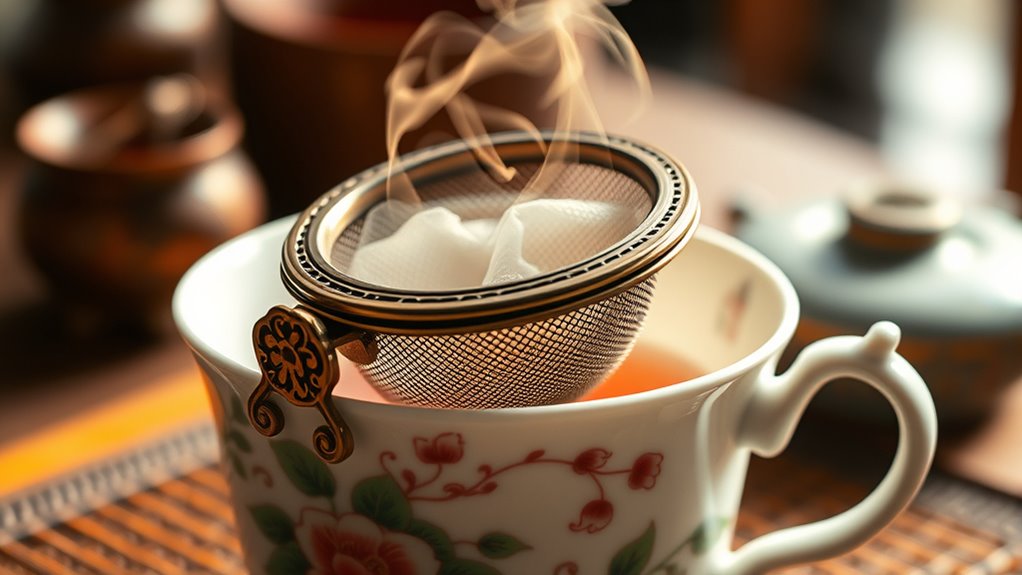
Tea infusers and strainers make brewing your favorite tea easier and more efficient. These tools have a rich history rooted in centuries of tea-drinking traditions and have evolved with diverse materials to suit different preferences and cultural practices. When you explore the origins of tea infusers, you’ll find that their history dates back to ancient China, where early methods involved simple cloth or mesh to hold tea leaves. As tea became more popular globally, especially during the Tang and Song dynasties, the need for more refined and reusable brewing tools emerged. During the Victorian era in England, the development of metal infusers gained popularity, offering durability and better control over steeping. Over time, the design and material of these infusers diversified, reflecting technological advances and cultural influences.
Today, material varieties of tea infusers and strainers are vast, and your choice often depends on personal taste or cultural tradition. Stainless steel infusers are among the most common, prized for their durability, resistance to rust, and ease of cleaning. They’re perfect if you want something long-lasting that doesn’t interfere with the flavor of your tea. Silicone infusers have gained popularity for their flexibility and vibrant colors, making them an attractive and practical option for those who prefer a softer material that won’t scratch your teapot or mug. Fine mesh strainers made of stainless steel or other metals are also widely used and are appreciated for their ability to trap even tiny tea particles, ensuring a smooth, sediment-free brew.
Ceramic or clay infusers are favored in certain tea cultures because they can enhance the flavor profile and are often part of traditional tea ceremonies. These materials can also withstand high temperatures, making them suitable for different types of teas. Bamboo or wood infusers, while less common, evoke a rustic charm and are valued for their natural aesthetic and eco-friendliness. Each material offers unique benefits and cultural significance, shaping the way you experience tea. The historical origins and material varieties of tea infusers and strainers reveal how deeply intertwined they are with cultural practices and technological progress. Whether you prefer a sleek stainless steel infuser, a colorful silicone one, or a traditional ceramic piece, understanding their history and material background enriches your appreciation for the simple act of brewing tea. It’s not just about convenience; it’s about connecting with centuries of tradition and craftsmanship that make every cup more meaningful.
Frequently Asked Questions
How Do Different Cultures Traditionally Use Tea Infusers?
In many cultures, you use tea infusers as essential utensils for tea brewing, appreciating their craftsmanship. For example, in China, you carefully select delicate, handcrafted infusers to enhance flavor, while in Japan, you might prefer traditional bamboo strainers. In the UK, you often use metal infusers for convenience. These utensils reflect cultural values, emphasizing the artistry and precision that go into making each cup of tea, making your tea experience more meaningful.
Are There Specific Materials Preferred in Certain Regions?
Using regional materials for tea infusers is like choosing the right brush for a masterpiece—you want what fits best. In some regions, you prefer stainless steel for durability, while others opt for delicate porcelain, symbolizing elegance and tradition. These choices reflect cultural material symbolism, where specific materials embody local values and craftsmanship. Your selection can enhance the tea experience, blending practicality with cultural significance.
What Rituals Involve Tea Strainers in Ceremonial Settings?
In ceremonial settings, tea strainers play a crucial role in enhancing ritual significance. You often use delicate tea infusers to carefully brew and serve tea, symbolizing respect and mindfulness. The act of straining tea becomes a mindful ritual, emphasizing patience and appreciation for tradition. These moments foster connection and reverence, making tea strainers an important tool in rituals that honor cultural heritage and spiritual practices.
How Has the Design of Tea Infusers Evolved Culturally?
You’ll notice that the design of tea infusers has evolved through historical innovations, making them more functional and user-friendly. Aesthetic influences, like intricate patterns and elegant materials, reflect cultural tastes and traditions. Modern infusers combine practicality with artistry, showcasing a blend of tradition and innovation. This evolution allows you to enjoy tea with a touch of cultural expression, enhancing your ritual while honoring historical craftsmanship and contemporary design trends.
Do Tea Infusers Hold Symbolic Meanings in Any Societies?
You’ll find that tea infuser symbolism varies across cultures, often representing hospitality and tradition. In some societies, giving a beautifully crafted infuser signifies respect and good wishes, embodying cultural interpretations of sharing and connection. While not universally symbolic, these items can hold special meaning, highlighting the importance of tea rituals and social bonds. So, your choice of infuser might reflect more than just taste — it’s a nod to cultural values.
Conclusion
You might think tea infusers and strainers are just practical tools, but they actually carry deep cultural significance, symbolizing hospitality and tradition across many societies. Some believe that using these tools connects you to centuries of tea-drinking customs, fostering mindfulness and community. So next time you prepare tea, remember you’re part of a rich history, where even a simple infuser helps preserve the cultural essence and shared rituals that make tea truly special.

